|
|
Post by vance on Jun 15, 2017 15:21:03 GMT -8
Sorry! Language can be tricky! The picture didn't help, either.
No, that's a Scuba on its side, hiding the exhaust horn. I'm not fitting the Scuba lid on the Deluxe to achieve a single hose double hose regulator! Yet.
I only meant that both models have this poor arrangement to mount the diaphragm. There's no flange to hold it in place. I was asking how people get their cans together (heh!) without the alignment slipping off as you maneuver the clamp around it and try to secure the screw. I just use the clamp shown. It isn't too tight, but it also helps to compress the bottom can onto the diaphragm to ease getting the stock clamp screw started when fitting a new silicone diaphragm!
|
|
|
|
Post by vance on Jun 15, 2017 15:31:21 GMT -8
By the way, John, I love that GLuba! It's as cool as my Misuba rev1! Above in glorious black and yellow:  
The Misuba sports a duckbill eliminator now, though! And, mine is an opposite result experiment. I wanted to eliminate the venturi and go stealth! This is so much quieter than the Mistral.... But it breathes well with further mods to the HP valve, as noted back a few pages! |
|
|
|
Post by SeaRat on Jun 15, 2017 16:45:20 GMT -8
I like the GLuba name! I'll post more, with a different photo, later.
Thanks,
John
|
|
|
|
Post by vance on Jun 15, 2017 16:52:31 GMT -8
I'm going to shift the lever assembly so that 1/2 the air is directed straight at the intake horn. I have a Scuba that's set like that and it works better than the stock direction, I think. There are so many variables....... it's hard to say what does what w/o instruments and good science.
|
|
|
|
Post by vance on Jun 16, 2017 8:15:38 GMT -8
I went the opposite direction, and fitted the Goldie innards into a first generation can/cover. It works well that way.  John The GL must have a different length HP valve body than the Scuba and the Deluxe to accommodate the "new" style yoke. It appears as if it is not interchangeable with the old style yoke as it must be longer. Is that why you've installed it on your Scuba? In writing the above, I begin to wonder if there are different HP bodies in the GL and Deluxe as there are in the Scuba? I haven't checked into this, but assume this to be the case since there were the same K and J restrictor options available in both of these later models as well. Roberts doesn't say much about the different restrictors available in his descriptions of these 3 models in "Basic Scuba". Neither have I run across any information about the different valve bodies and nylon plungers anywhere else. This seems like it would be critical information, as the parts aren't always interchangeable! You can't simply drop one kind of plunger into the other kind of valve body since it would create too much or too little spring tension on the seat. |
|
|
|
Post by SeaRat on Jun 16, 2017 11:58:13 GMT -8
Phil,
No, I didn't keep the newer yolk because of fit. I think both would fit the Goldie body, but I like both the streamlined profile and the non-entanglement design of this newer yolk style. I carry a dive flag and line on most of my dives now, and entanglement in the currents I currently dive is a constant problem. I really have not checked the valve sizes, so my comment is an assumption. My assumption is that the Healthways engineers would want to keep backwards compatibility, but it is only an assumption.
By the way, for your hybrid Healthways SCUBA guts inside the USD can, you would have slightly better breathing if you moved the levers so that they are at 90 degrees to the intake horn. This gives a slight Venturi to the breathing cycle. The air escapes from the sides, along that curved surface. I hear you on the quietness of this configuration, as the Mistral is about the noisiest double hose regulator ever produced. The original Healthways is almost as quiet is the original DA Aqualung, but breathes much nicer.
John
|
|
|
|
Post by vance on Jun 16, 2017 15:42:55 GMT -8
I'm thinking that the lengths of the HP valve on Scubas and the GL Scuba are going to be different. You can definitely trade the WHOLE valve/yoke assembly from one model to another, but I'm betting you can't mix HP valves and yokes on Scubas and GLs.
These are my theories: the Deluxe and the Scuba share the two different valve bodies, depending on K or J configuration. This is a fact (see pics back a few pages). The GL body may have come in two lengths, depending on which restrictor it used, and may or may not be different than the Scuba/Deluxe valve bodies.
I don't know for sure, but in the Scuba, I think the machined restrictor plate came in a long HP body, and the stamped restrictor came in the short HP body*. At least, this is based on the 6 Scubas I have torn down, which had both setups.
I think the Deluxe had the same long/short valve configuration. However, I've only taken 3 apart and they all had the stamped restrictor and the short valve body. I have not seen a Deluxe with a machined restrictor or the long body. Anyone have one???
I will measure a GL valve and compare it to the Scuba valves soon to find out if they are different. I have another GL coming which will need a tear-down and rebuild, so I won't have to take my finished one apart. Again. These also came with the K and J configuration. Does anyone have a GL with a machined restrictor?
*To be read by and considered by only the geekiest of regulator nerds:
I don't think the machined and the stamped restrictor plates fit very differently inside the valve body. The difference in thickness which affects the spring tension is minimal. The difference in overall thickness is significant, but the spring fits into a machined depression in the thick one and into a stamped bulge in the other. I don't think this can effect more than a millimeter difference between them. Thus, the different valve bodies and nylon plungers may have been used for some other reason?
|
|
|
|
Post by nikeajax on Jun 16, 2017 16:32:27 GMT -8
Dang son: when the Healthways bug bites, it usually leaves a nasty welt, but for you I think it left a laceration and a big ol' scar!
JB
|
|
|
|
Post by SeaRat on Jun 16, 2017 16:54:11 GMT -8
Phil, I don't think the amount of spring tension matters to a large degree. This is an upstream valve, and the main point in the spring is to hold the valve body against the seat, and when the air pressure is turned on the air pressure further pushes against the seat, ensuring a seal.  Here are the components, with the restrictor orifice.  This was one of my configurations, using my twin 50s before I decommissioned them (still have them though).  Here is a top view of this configuration, with all the advantages of a double hose regulator, with also the safe second provided by a completely redundant Sherwood Magnum Blizzard regulator, complete with my dive computer and a LP inflator for my BC. My initial understanding was that the LDS could change out the restrictor for a regular larger orifice plate (the J-valve plate) on-site. This would ensure that the diver had the correct configuration for the tank set that he had (J-valve or K-valve). John |
|
|
|
Post by vance on Jun 16, 2017 17:39:33 GMT -8
It does matter when you have mixed up a long body with a short plunger. It will cause a drastic difference in the lever height, and will cause a very mushy condition which may not keep the valve closed. My Misuba rev1 regulator utilizes this effect in order to achieve very easy inhalation. I haven't yet tried it, but my fear is that it will freeflow uncontrollably. I hope to test it soon.
|
|
|
|
Post by vance on Jun 16, 2017 17:45:43 GMT -8
Your picture shows a long valve body with a machined restrictor, a translucent valve plunger, with the tall spacer. This is the correct non-venturi valve K setup. If you take this apart and install a white or black plunger, you will notice a big drop in the lever height and a very mushy feel. Please refer to my pictures on pg7 of this thread.
|
|
|
|
Post by SeaRat on Jun 16, 2017 18:59:41 GMT -8
|
|
|
|
Post by vance on Jun 17, 2017 8:35:14 GMT -8
That might be the only original duckbill left intact on earth. I have tried to get them out by soaking them in silicone spray for a week, but they never come out whole. Mine have all been very hard and delaminating. They look like layers of paper covered with black tar. I wonder what they were made of... I've read that they were dipped in latex, but don't know what the body was made out of.
|
|
|
|
Post by nikeajax on Jun 17, 2017 10:28:52 GMT -8
Phil, I wonder: is he inside latex, and the outside neoprene: that would explain the color? Both latex and neoprene are prone to oxidation, and don't do well with prolonged exposure to salts...
As for your silicone DB, what if you just reinforced the part that gets the clip?
JB
|
|
|
|
Post by vance on Jun 17, 2017 12:51:54 GMT -8
Phil, I wonder: is he inside latex, and the outside neoprene: that would explain the color? Both latex and neoprene are prone to oxidation, and don't do well with prolonged exposure to salts... As for your silicone DB, what if you just reinforced the part that gets the clip? JB My original HW duckbills look like they're made of paper. I'm sure they aren't, but have that look. You are probably right about neoprene coating the outside, but I don't know. I just rtv the duckbill in the horn. That seals the tube of the duckbill to the inside of the horn. This way water or air can't get past it either direction. I don't bother using the clip, except when the rtv is wet so the sides are expanded into the groove in the horn. Then I take it out. It seems to work fine! |
|